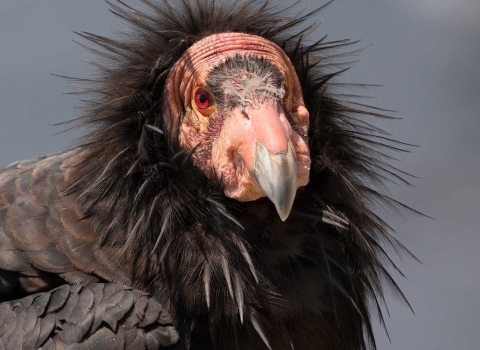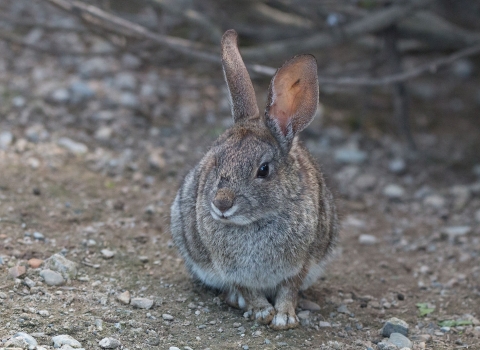The Panoche Hills rise out of the San Joaquin Valley floor west of Fresno, California. They are steep and dry, creating an environment that only the heartiest desert plants and creatures can call home, including the endangered blunt-nosed leopard lizard. In May, biologists from the U.S. Fish and Wildlife Service joined representatives from the Fresno Chaffee Zoo, Bureau of Land Management and California Department of Fish and Wildlife to release 10 blunt-nosed leopard lizards back onto the landscape, reaching a milestone 2 years in the making.
For many years, blunt-nosed leopard lizards raced around the Panoche Hills Plateau, an area managed by the Bureau of Land Management. The lizard’s cream and tan stripes blended their bodies into the harsh landscape and kept them camouflaged from predators like coyotes and hawks. Reaching nearly 8 inches in length (not counting its long whip-like tail), the blunt-nosed leopard lizard is famous for its ability to run on its hind legs.
A few years ago, biologists working for BLM noticed that the blunt-nosed leopard lizard population was declining on the plateau to the point where survival of the population was in question. Working alongside the Service, CDFW, Fresno State and the Fresno Chaffee Zoo, a plan was put in place to collect the remaining lizards on the plateau and bring them into the Fresno Chaffee Zoo for a captive breeding program.
“All of the partners realized that we could play an important role in the recovery of this population of blunt-nosed leopard lizards,” said Justin Sloan, senior wildlife biologist in the U.S. Fish and Wildlife Service’s Sacramento Fish and Wildlife Office.
Of the five lizards brought into the care of the Fresno Chaffee Zoo, three were female and two were male. In the first breeding season, the five lizards produced 20 offspring. The next breeding season, another 42 lizards were born. The Fresno Chaffee Zoo kept close track of the offspring’s genetics to avoid inbreeding as much as possible. By the end of 2022, the partner organizations agreed that releases to the Panoche Hills Plateau could begin in 2023.
But huge storms drenched California during the latter part of 2022 and early 2023. The normally arid plateau received a record-breaking amount of rain, giving life to grasses that grew tall and thick in the spring of 2023.
“Blunt-nosed leopard lizards prefer areas with less-dense grasses where they can easily spot and flee from predators, as well as forage,” said Sloan.
In the days leading up to the release, BLM and the Fresno Chaffee Zoo mowed patches of grass in areas where the blunt-nosed leopard lizards previously lived on the plateau. Some patches were connected by mowed strips while others weren’t. The variation in mowed patch connectivity will provide biologists with a unique opportunity to learn more about the lizard’s preferences and movement related to grassland habitat.
On May 17, 2023, five female and five male year-old blunt-nosed leopard lizards were transported from the Fresno Chaffee Zoo in large coolers to the Panoche Hills Plateau for release. Before the release, biologists located small mammal burrows in each of the mowed areas and marked them with little, pink flags. Blunt-nosed leopard lizards use underground burrows of kangaroo rats and other mammals for coverage from predators and for temperature regulation during the hot summer months.
“Blunt-nosed leopard lizards will cohabitate with other animals, like kangaroo rats, but they don’t share burrows systems with other leopard lizards unless they are a breeding pair,” said Sloan.
Back at the coolers, the lizards were each fitted with a radio transmitter collar. Powered by a small battery pack, the transmitters will send out signals for about 18 weeks and help biologists locate the released animals. The collars and antenna do not restrict the lizards or affect their ability to run or scramble into hard-to-reach places. The lizards also received a small passive integrated transponder, or PIT tag, that’s inserted under the skin. PIT tags are scannable and contain identification information for that individual.
Small teams each took a lizard to one of the locations marked with a pink flag, and slowly, the lizard was placed on the ground next to the burrow.
“We thought they would dart into the burrow, but they didn’t move much at first. They were still warming up in the sun,” commented Sloan. “Eventually, they ran off under the bushes.”
Going forward, the Fresno Chaffee Zoo plans to send researchers out on a weekly basis to check-in on the released individuals. The Fresno Chaffee Zoo also aims to hatch 80 to 100 lizards a year to maintain the captive breeding colony while continuing to release blunt-nosed leopard lizards into the Panoche Hills Plateau until a self-sustaining population is in place.
“The captive breeding and release of blunt-nosed leopard lizards back onto the Panoche Hills Plateau provides us with a semi-controlled situation where we can learn even more about this unique species. With data tracking and transponders, we can learn more about their ecology such as habitat and burrow preferences,” said Sloan.
As the Service celebrates the 50th anniversary of the Endangered Species Act, this effort reflects how every species recovery depends on the dedication of many partners. The careful work by staff at the Fresno Chaffee Zoo demonstrates that the species can be bred successfully in captivity. If other populations in the San Joaquin Valley start to decline, the Fresno Chaffee Zoo could possibly implement a similar breeding program. BLM will continue to manage the habitat for the lizard on the Panoche Hills Plateau.
“It’s great to see the agencies and organizations come together to complete a project of this magnitude. We will learn so much about the species and how to help it recover,” said Sloan.










